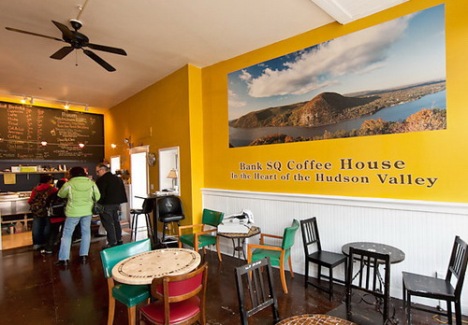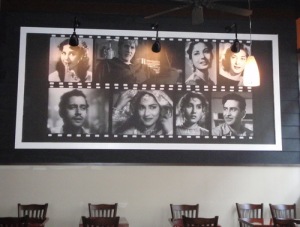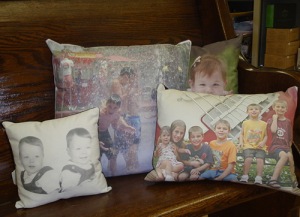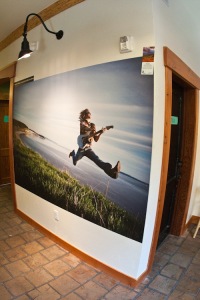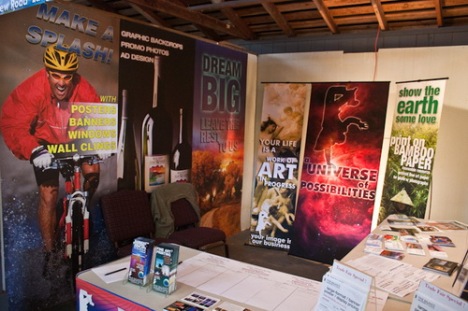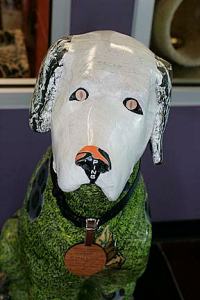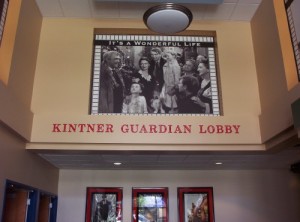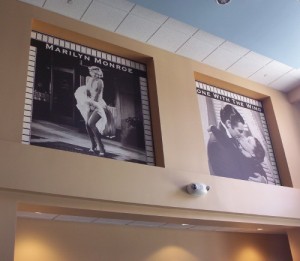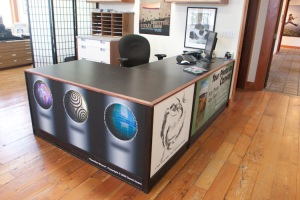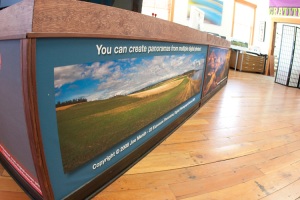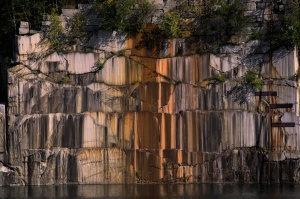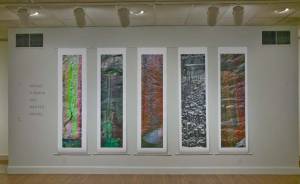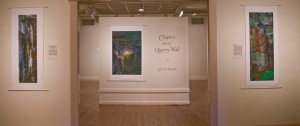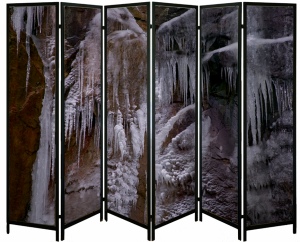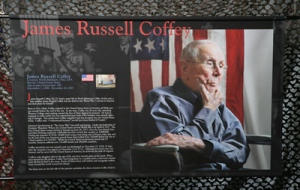A well-crafted surfboard is a work of art—especially when it’s embellished with images that evoke the awesome power and beauty of nature that surfers experience while riding the waves. That’s why surfer/artist/photographer/musician Kem McNair of New Smyrna Beach FL came up with the idea of creating limited-edition Surf Artboards. Each Artboard incorporates a giclée reproduction of one of McNair’s surf paintings and is custom-manufactured by McNair himself. The boards can be ordered through Kem McNair’s website (www.kemmcnair.com) along with limited-edition canvas prints and posters of some of the thousands of paintings, illustrations, and photographs McNair has created over the past 40 years.

Kem McNair combines his surfboard-manufacturing experience and art talents to reproduce his paintings on wall-art replicas of longboards. Shown here: Shane Smith helps with some of the fiberglass work.
Kem McNair started surfing when he was a child, and is so passionate about the sport and the surfing culture that he has built his career around it. He has won regional and East Coast championships, surfed and photographed waves in exotic locations all over the world, and worked in a surfboard manufacturing studio.
Since he began painting surfboards in the mid-60s, he has airbrushed and hand-painted over 10,000 surfboards and created thousands of surfing-related T-shirt designs and illustrations. Recently, some of his watercolor and oil paintings were accepted for inclusion in a regional juried art show. Plus, he shoots photographs of local surfers—primarily in the inlet where he continues to surf as often as possible.
The first Surf Artboards McNair produced were hand-painted, 42-in. miniature surfboards that were time-consuming and expensive to produce. But thanks to the wide-format Epson Stylus Pro 7600 inkjet printer he uses and the 3P Universal Light inkjet-receptive polyester fabric that he purchased from LexJet, McNair has discovered that he can scale up the size of each Surf Artboard while keeping the selling price affordable enough for many surfing enthusiasts. Now, he can make the Artboards in whatever size a client might want.
For a client in Colorado, he recently custom-made a longboard decorated with a reproduction of his “Rainbow Tube” painting. At 6 ft., 6 in. long, the Surf Artboard is 2/3 the size of a real longboard and packs a more powerful visual punch than the 42-in. miniature surfboards.
“What made the whole thing work was the fabric I bought from LexJet,” says McNair. Not only was the fabric more durable than some of the inkjet art and rice papers he had previously tried with his ArtBoards, but “The colors were insanely great!” On the 3P inkjet fabric, the colors didn’t look muted or subdued as they had on some of the inkjet papers that McNair had tried.
Plus, the polyester material held together nicely when the resins were squeegeed on top of the print. Nor did the inks on the 3P fabric run as they had on some of the art papers. Even when the print is encapsulated in resin, which is then laminated with fiberglas, sanded and polished, the 3P Universal Light fabric still displays a subtle bit of tooth that makes the finished art look more like a painting than a print. McNair signs and numbers each print before coating it with the clear resin.

This 78 in. board, which features an encapsulated, signed and numbered reproduction of one of McNair’s paintings, now decorates one of the office walls of surfing enthusiast in Colorado. “It looks like a fine piece of furniture,” says McNair. “It’s highly glossed and polished, like we used to produce boards in the old days.” (www.kemmcnair.com)
Custom-imaged ArtBoards are just one example of the type of innovative, custom products that you can create with some of the dozens of different inkjet-printable materials available from LexJet. If you have an idea for a new product you might like to create with your inkjet printer, call a LexJet account specialist at 800-953-9538.
“Tell us what you have in mind, and we can recommend some options for getting the job done—including some inkjet-printable materials you might not have considered,” says LexJet account specialist Katie Rizi, who recommended using the 3P Universal Light fabric for Kem’s ArtBoard project.
You can read more about the steps used to create surfboard art in the next issues of LexJet’s Expand and In Focus newsletters. See more of McNair’s artwork by visiting his online gallery at www.kemmcnair.com
When you visit Kem McNair’s website, be sure to check out his famous “shark jumping the waves” photograph that went viral online and was featured on CNN, FOX News, MSNBC, Inside Edition, and many other media outlets. Some skeptical bloggers speculated that the shark-jumping image was a clever bit of Photoshop trickery. But McNair insists he just happened to be taking action shots of some surfers when he captured a natural phenomenon that he and his fellow surfers at New Smyrna Beach see more often than they might like.
Filed under: Decor Printing, Photography Business, Uncategorized | Tagged: 3P Universal Light, custom wall art, inkjet-printable fabric | Leave a comment »





